► Striking E-3008’s new coupe-crossover look
► Up to 98kWh battery for 435-mile range
► UK deliveries in spring 2024
Peugeot is radically reinventing its 3008 crossover with pure electric power, a clean-sheet vehicle architecture and a striking new design inside and out.
The midsize SUV has been critical to Peugeot’s renaissance, selling 1.32m units of the second-generation 3008 since 2017.
‘It’s a flagship for the Peugeot brand and the car that others in the C-SUV sector measure themselves against,’ says global head of marketing Phil York. And that’s not a groundless boast: Renault admits its lack of a 3008 rival has held the brand back, so it’s introducing the new Scenic E-Tech as a rival.
The headline news is that the 3008 is the lead car on Stellantis group’s STLA electric car platform. This ‘medium-sized’ chassis will underpin an expected two million cars per year, starting with the Peugeot which lands in UK retailers in spring 2024.
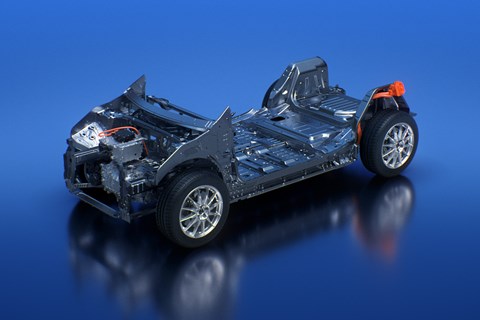
Stellantis says it designed STLA Medium primarily as an electric car, but there will be a 1.2-litre mild hybrid and plug-in hybrid versions. It’s the E-3008 that’s the launch model, available with two big lithium-ion NMC batteries.
The entry-level battery has 73kWh of usable energy, the long-range pack a mighty 98kWh. If you believe in EVs with right-sized batteries that consume fewer resources, look away now. But if you value big ranges, Peugeot reckons the standard pack covers 326 miles, the long-range variant a whopping 435 miles.
Unlike in new Teslas where the battery pack is the floor of the car, the E-3008 has a steel underbody on top of the battery casing. Nonetheless the battery makes the new 3008 stiffer than its predecessor and contributes to the car’s crash performance by acting as a brace.
Specs of the E-3008 standard and long range versions
The standard range E-3008 has a 157kW permanent magnet synchronous motor (213bhp) turning the front wheels. With 253lb ft of torque, the electric Peugeot can sprint from standstill to 62mph in 8.7secs, despite weighing a hefty 2114kg (similar to a Volkswagen ID.4).
Customers will also be able to choose a dual-motor version. This adds an 83kW (111bhp) motor to the rear axle for a combined 324bhp, and a 6.4secs acceleration time. This is the heaviest E-3008, weighing 2199kg.
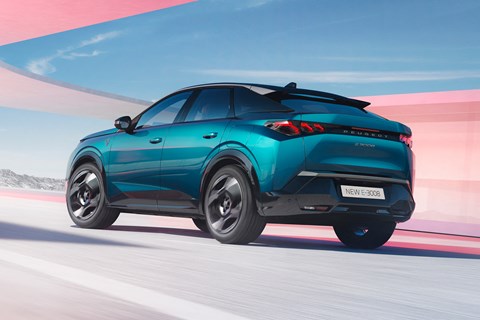
The 98kWh long range version uses a 170kW motor (233bhp), and while the extra mass adds two-tenths to the standard range’s 0-62mph time, drivers will get an extra 109 miles according to the WLTP test cycle.
New E-3008: efficiency and charging
Peugeot claims STLA Medium has been optimised for best-in-class efficiency of 4.47 miles per kWh: we won’t know for sure until test drives this winter. The battery is liquid cooled and a heat pump optional.
The E-3008 has a 400-volt electrical architecture and the standard on-board charger enables 11kW AC charging (from a three-phase wallbox), and 160kW DC charging across the line-up. That restores 100km (62 miles) in 10 minutes, with the E-3008 going from 20 to 80 per cent in 30 minutes.
Both the front and rear motors can regenerate the battery under braking. Three brake modes – low, medium and high – can be selected via steering wheel paddles. The E-3008 body is suspended by struts up front and an independent multi-link axle which creates space for the rear motor; combustion powered models get a twist beam.
How big is the new E-3008?
The E-3008 has grown by about 100mm compared with the previous generation model, taking it to 4542mm long. That’s a bit shorter than VW’s ID.4.
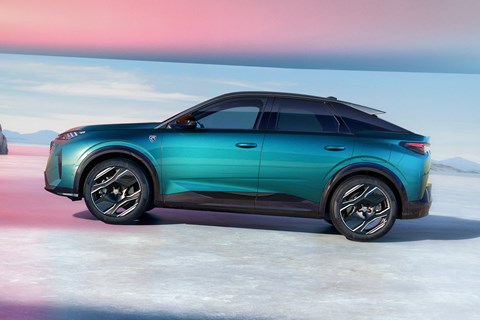
The E-3008 is 54mm wider than before to create extra battery capacity, ensuring they can be stowed in a single tier to lower the centre of gravity. The wheelbase is 64mm longer to boost interior space, and the boot stows 520 litres (dropping to 470l on all-wheel drive cars).
A striking evolution of Peugeot design
The E-3008 is clearly recognisable as a Peugeot and includes many of its core design cues, while strikingly evolving them. The ‘three-claw’ light graphic from the 9X8 race car is used for the Daytime Running Lights, which blend into a shimmering and distinct grille: unlike Tesla, Polestar and Ford EVs, Peugeot isn’t abandoning the grille.
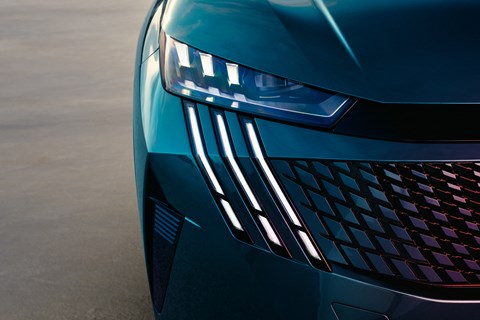
The roofline is more coupe-like than its predecessor’s boxier, SUV shape: Peugeot calls it a fastback SUV. And it has plenty in common with Peugeot’s other fastback – the 408 – employing a similar, triangular rear window graphic and rear spoiler with ‘cats ears’ at the sides.
The body surfaces are far less faceted than the 408’s: ‘it’s quite clean, you don’t have many, many lines’ says design director Matthias Hossann. He says that’s because the 3008 is a mature product, whereas the hatchback 408 is trying to gain presence in the executive car segment.
The clean look is enhanced by hidden waistline seals, like the new Range Rover’s. But the budget didn’t extend to flush, aerodynamic door handles, though triangular bumper sections manage air flow along the side then reduce drag at the rear.
Entry-level Allure trim gets 19in aerodynamic wheels; we’ve only seen the GT version, which rides on 20s.
Inside the new E-3008
The GT’s interior has a beautiful, lounge-like vibe, with a 21inch curved screen that stretches from centre console to driver’s binnacle and is cleverly mounted to seemingly float above the dashboard.
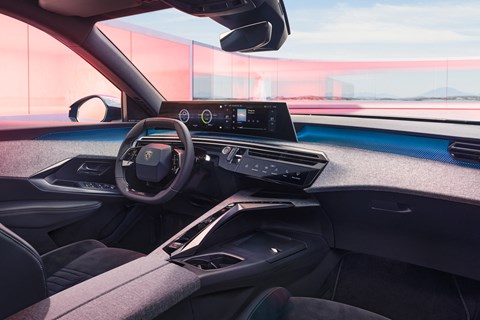
That’s wrapped in grey textile and is highlighted by curved metallic inserts, beautifully backlit with a choice of ambient colours. The Alcantara seats have the Peugeot logo embossed in the head restraints.
There are very few physical buttons, but Peugeot has doubled the number of shortcut ‘iToggle’ haptic pads to 10, to which you can programme your favourite setting (such as cabin temperature and fan speed on the climate switch).
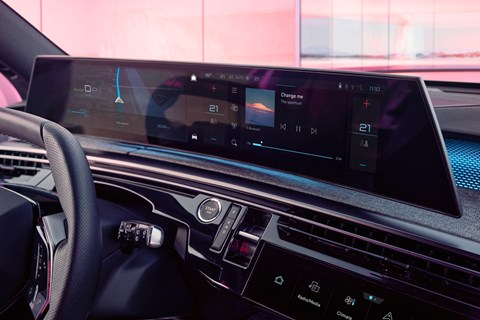
Peugeot says the E-3008 will offer a range of connected services, including over-the-air updates and clever, real-time route planning taking remaining range into account (powered by Tom Tom).
Six muted paint colours are available, and three GT option packs offer a sunroof, assisted driving and a Focal hi-fi, plus powered leather seats with heating, cooling and massaging functions.